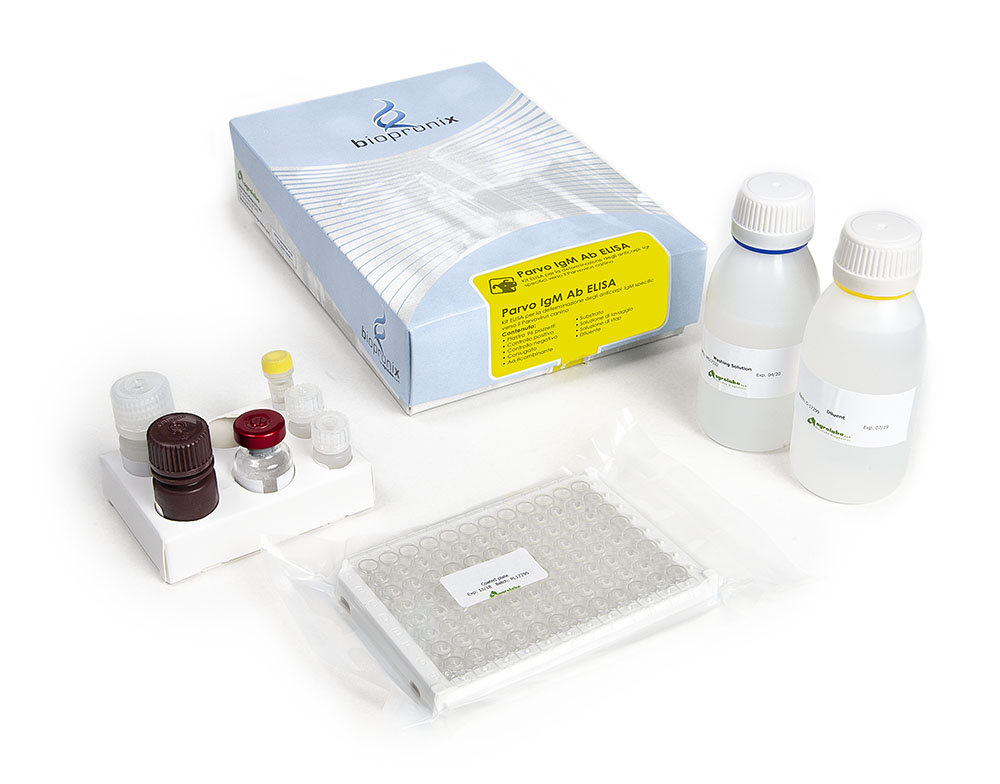Parvo IgM Ab ELISA
ELISA kit for the detection of IgM antibodies to canine Parvovirus
This kit is based on the indirect ELISA immunoassay technique for the detection of IgM antibodies to canine Parvovirus (CPV) in canine serum or plasma samples.
Parvo is a very contagious viral disease that can be potentially fatal, especially in unvaccinated puppies.
The responsible virus is classified as Canine Parvovirus Type 2 (CPV 2), to distinguish it from another Parvovirus (CPV 1) found in dog feces, without pathological significance. It is a very resistant virus in the environment (up to 1 year) and to the action of detergents and disinfectants.
The virus is excreted in the faeces and multiplies in the digestive tract and bone marrow. Penetrated into the body orally, after an incubation period of 3-8 days, the virus initially replicates in the oropharyngeal lymphatic tissues, from which it spreads haematogenously to all tissues. Then, the virus localizes in the lymphohemopoietic tissues of the bone marrow and to the lymphoid tissues of the jejunum and ileum, where it causes respectively neutropenia, lymphopenia, destruction of the intestinal villi with necrosis of the epithelium and hemorrhagic diarrhea. After 3 days from infection the animal starts to eliminate the virus.
Infection can occur by direct contact with the faeces of infected dogs or indirectly through exposure to the environment or to contaminated objects, such as litter or bowls.
Parvoviral infection can affect dogs of any age, although most cases puppies aged 6 weeks to 6 months are infected. Unvaccinated or partially vaccinated animals have a considerably higher risk of developing parvo.
Some breeds have been reported to be predisposed to canine parvovirus infection, such as Dobermann Pinscher, Rottweiler, English Springer Spaniel, German Shepherd, American Pit Bull Terrier and Dachshund. Once dogs are infected, they tend to develop more severe symptoms.
Toy Poodles and Cocker Spaniels seem to present a reduced risk of canine parvovirus infection. Puppies whose mothers have been regularly vaccinated are also affected less frequently and severely by parvo. This is because vaccination from the mother increases the levels of circulating maternal antibodies in young puppies. Canine parvo is present worldwide. The first cases of canine parvovirus supported by CPV were observed in 1978 in US. The disease spread rapidly throughout the world, affecting wild canids and domestic dogs, soon becoming an endemic disease.
The course of parvo is variable from subject to subject even within the same litter. There are basically two clinical forms: one gastrointestinal (of variable severity) and one cardiac; however, a sub-clinical form is also recognized.
Gastrointestinal form
After a short incubation period, the following appears:
- vomiting and diarrhea with blood
- anorexia
- depression of sensorium
- dehydration rapidly set in and, sometimes, even mild hyperthermia
- leukopenia (<3000 cells / mm3) with marked lymphopenia.
.
The course is variable and a slow recovery or a worsening of the general conditions with death of the affected subjects can be observed.
Cardiac form
Clinical evolution is rapid and 2-4 weeks old subjects die with the signs of acute myocarditis.
Subclinical form
It is perhaps the relatively most frequent form, characterized by:
- mild sensorium depression
- anorexia
- mild diarrhea
- modest leukopenia / lymphopenia.
.
The development of the sub-clinical form, sometimes asymptomatic, is closely correlated with the degree of immunity of the animal at the time of infection. Obviously, this is a partial immunity that does not prevent the replication and excretion of the virus. This clinical form takes on a different epidemiological importance depending on the type of life of the animal. In a puppy living in a family environment, the infection will have a limited epidemiological impact; on the contrary, the same situation projected inside a breeding / kennel takes on a completely different implication, as the infected animal eliminates the virus with the feces and can transmit the infection to other subjects.

